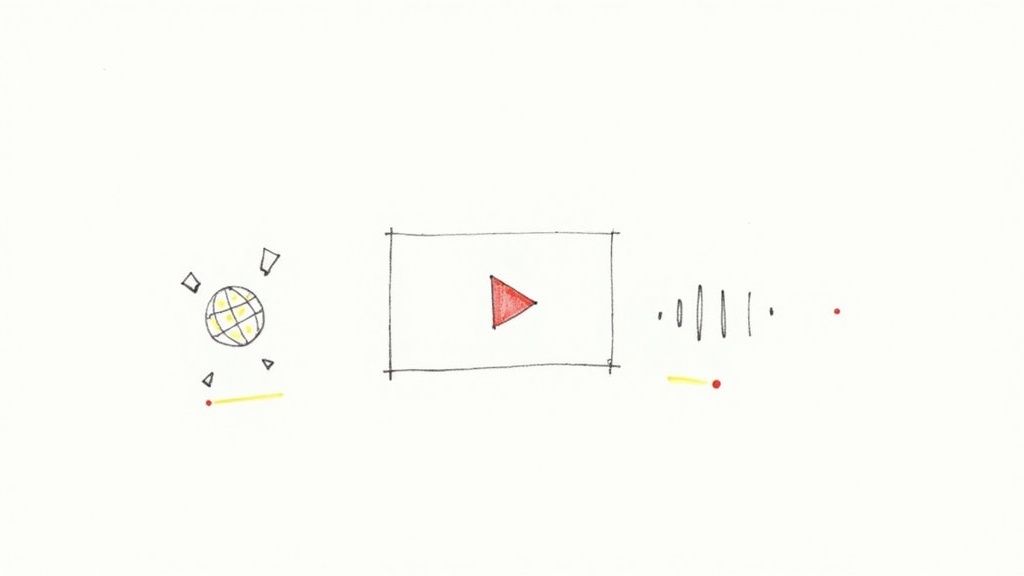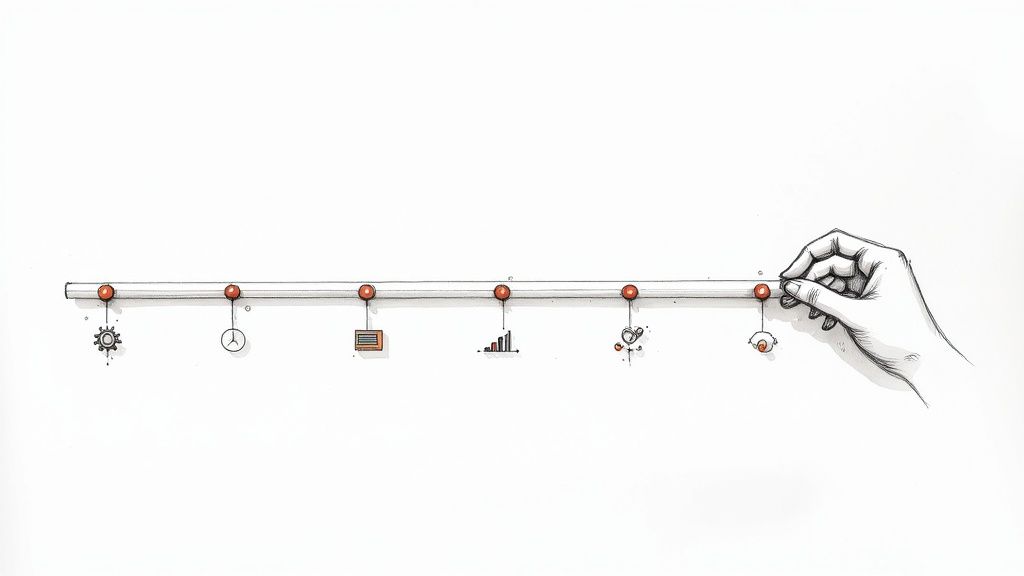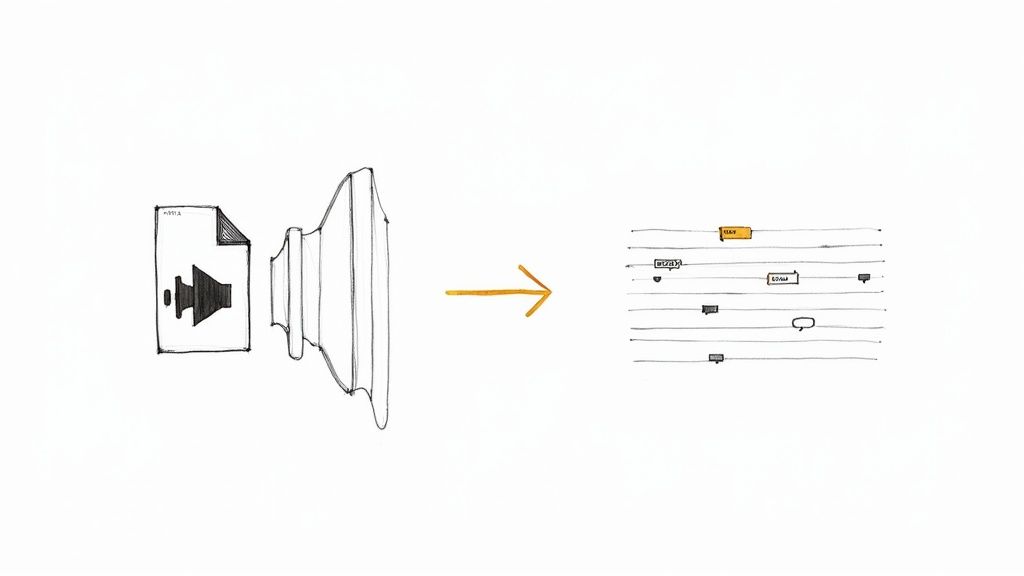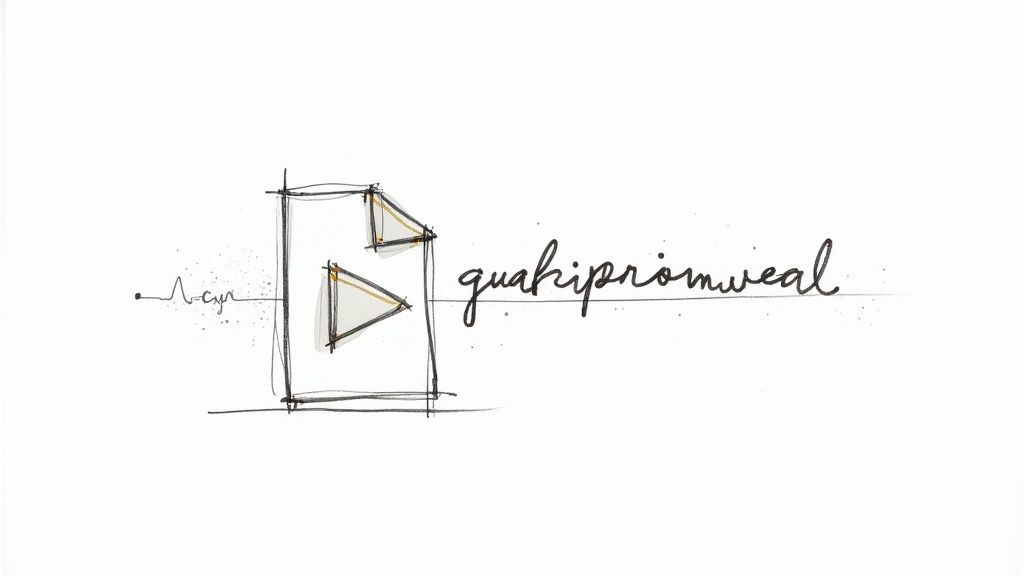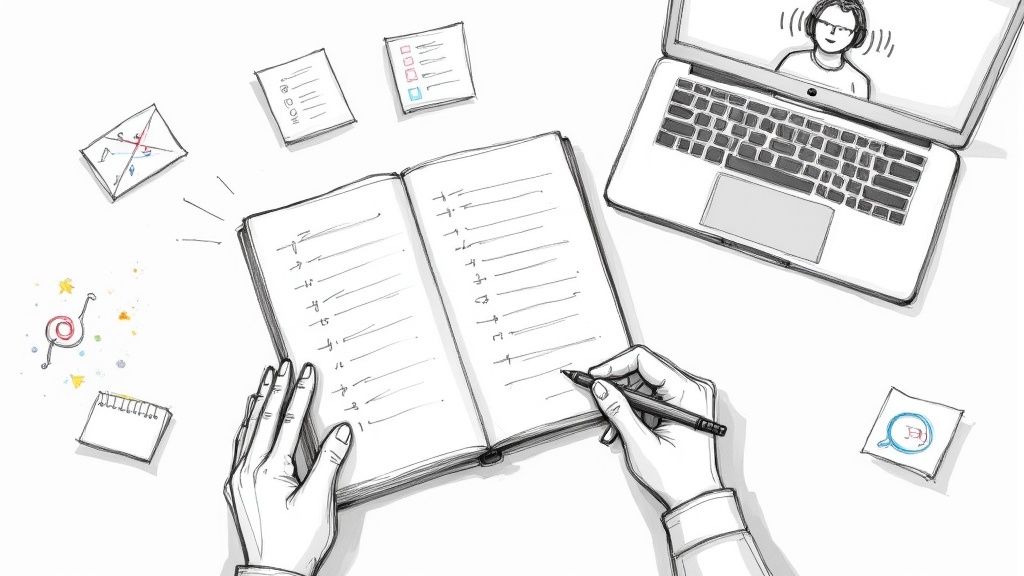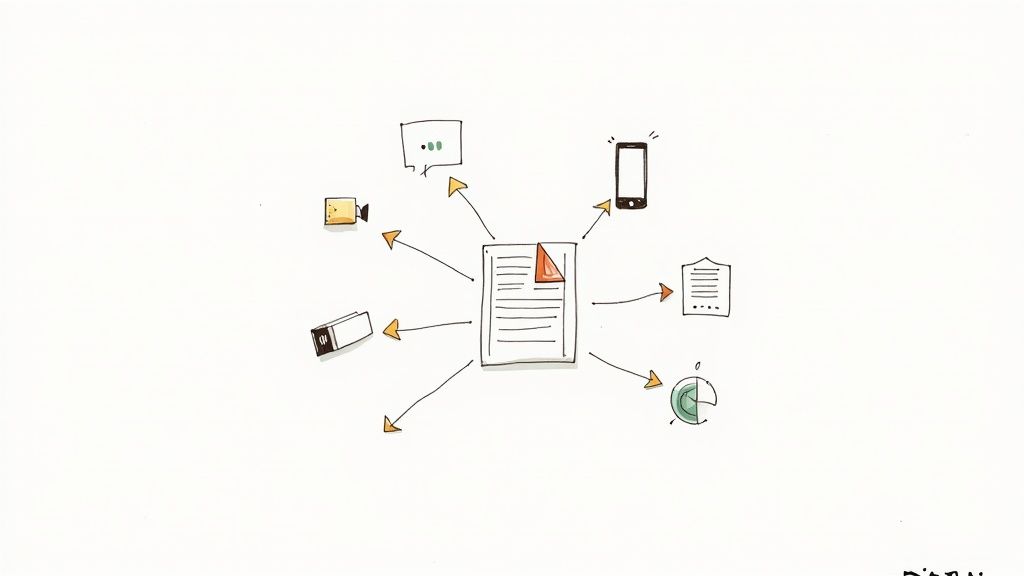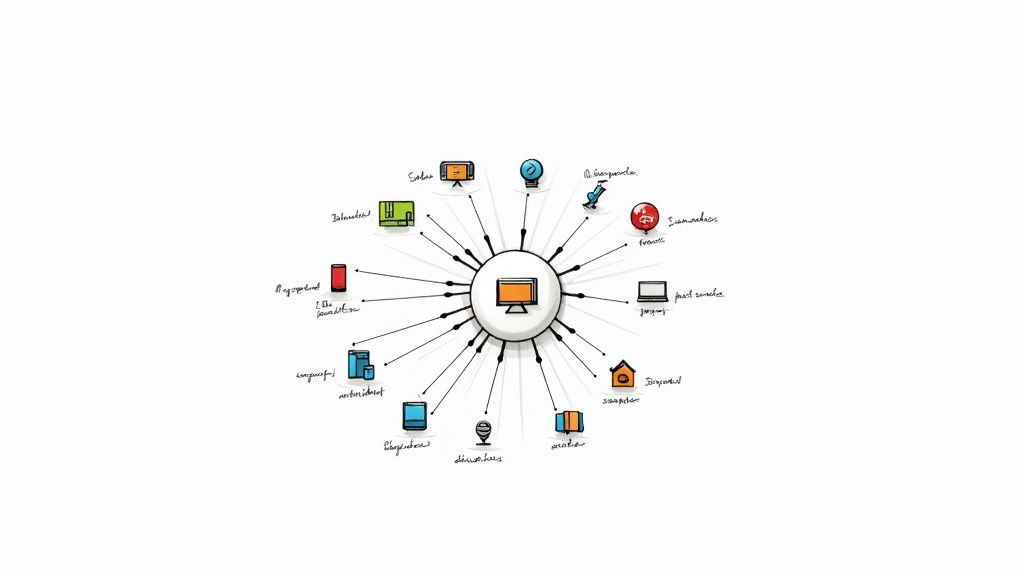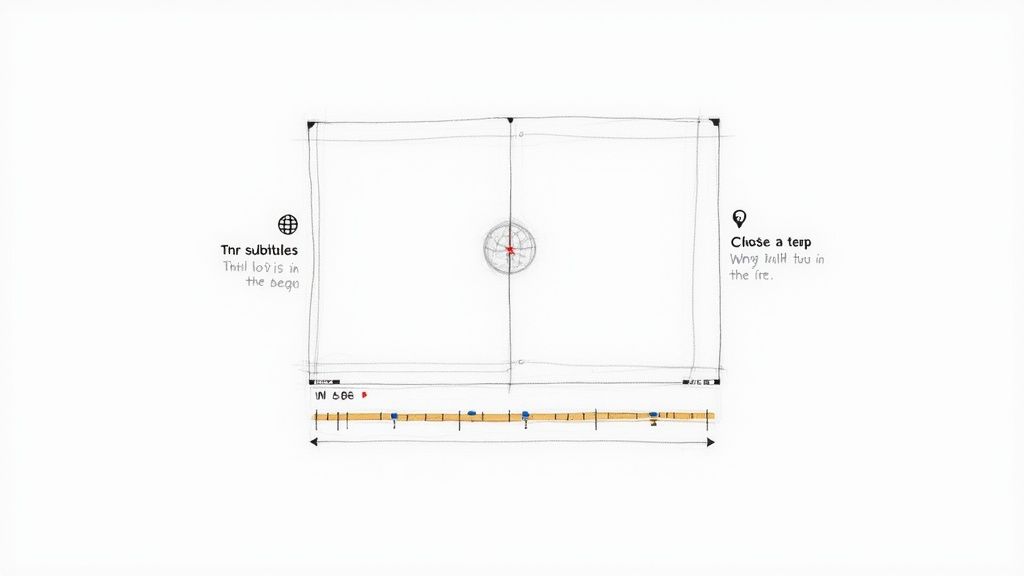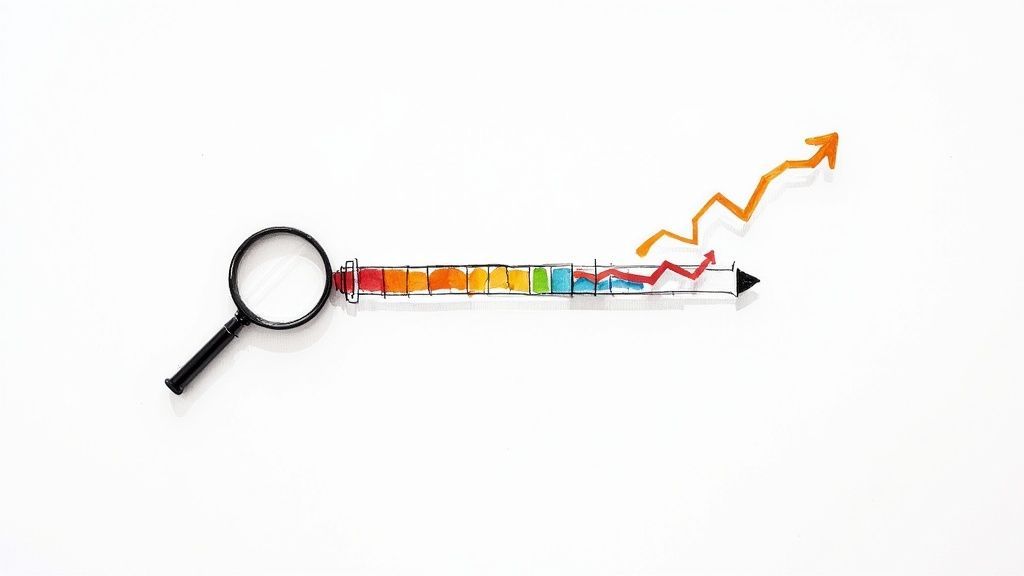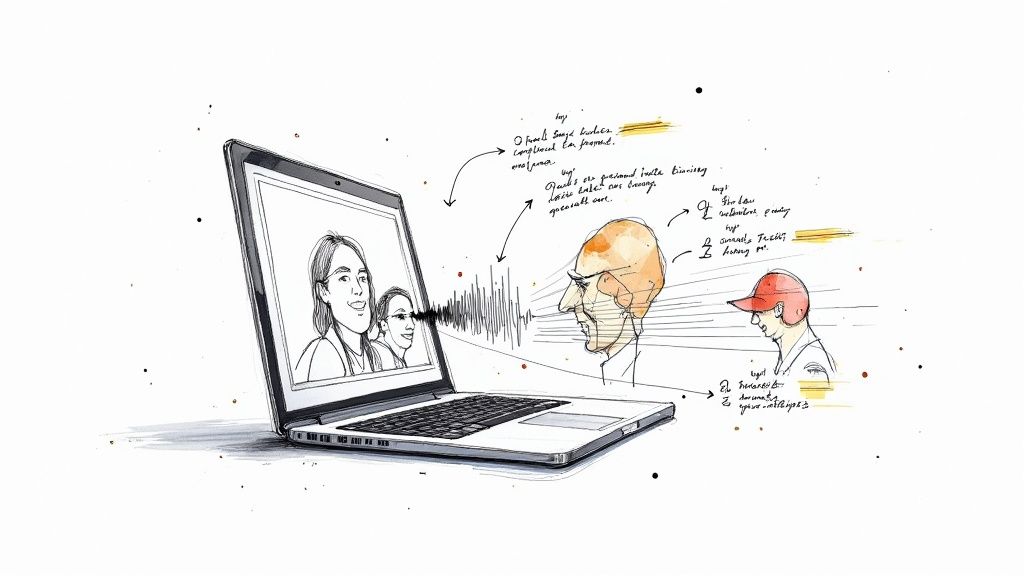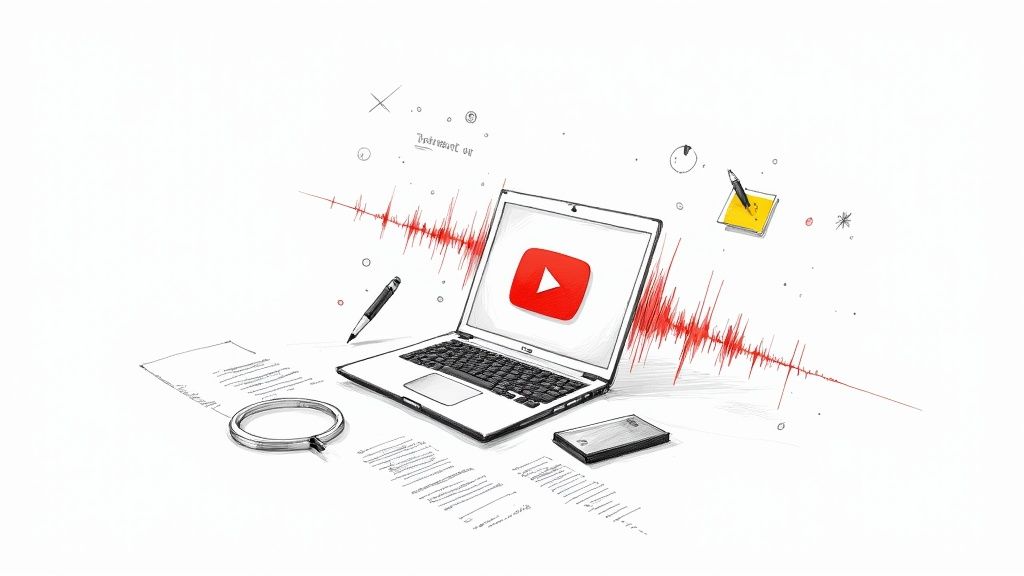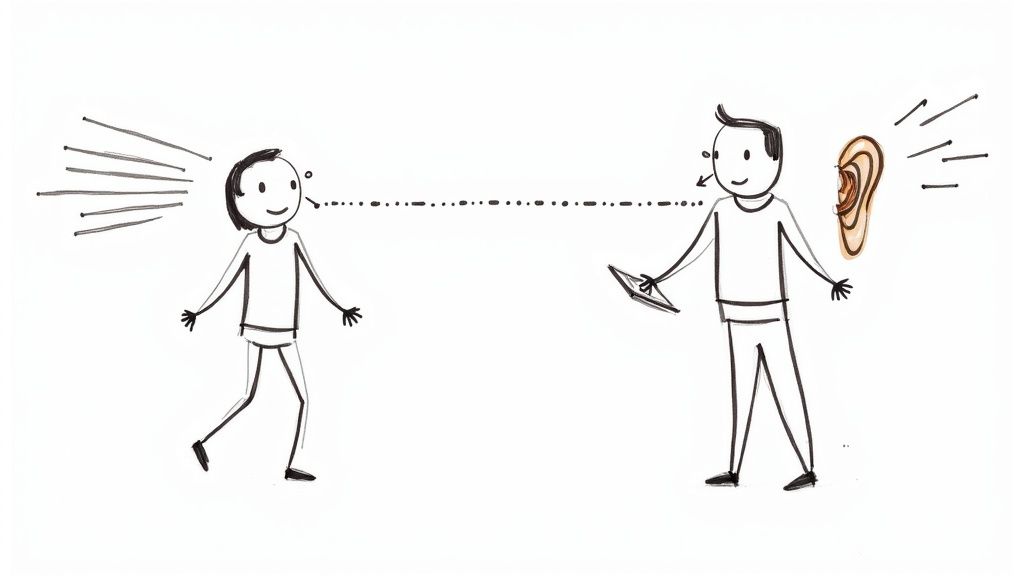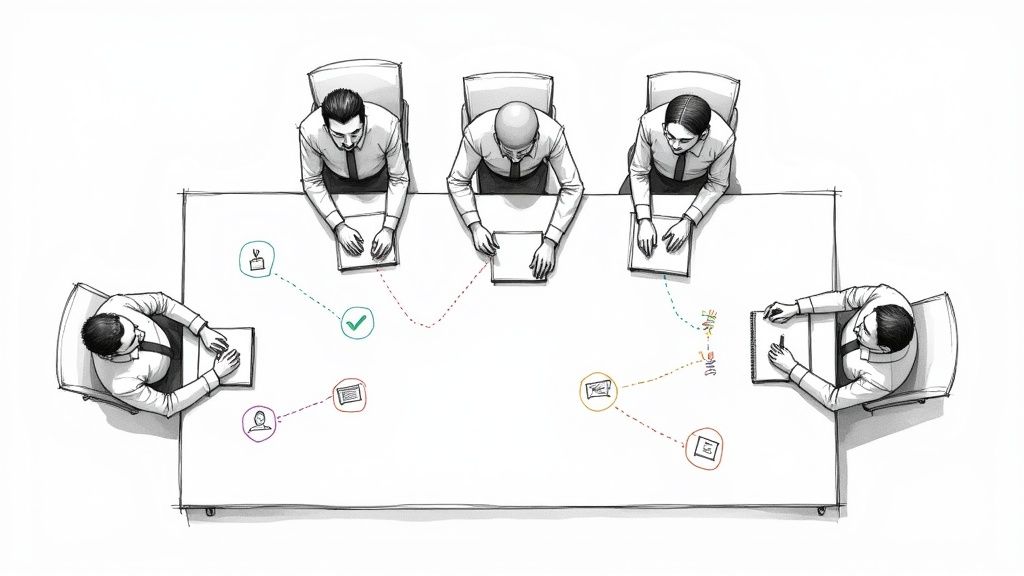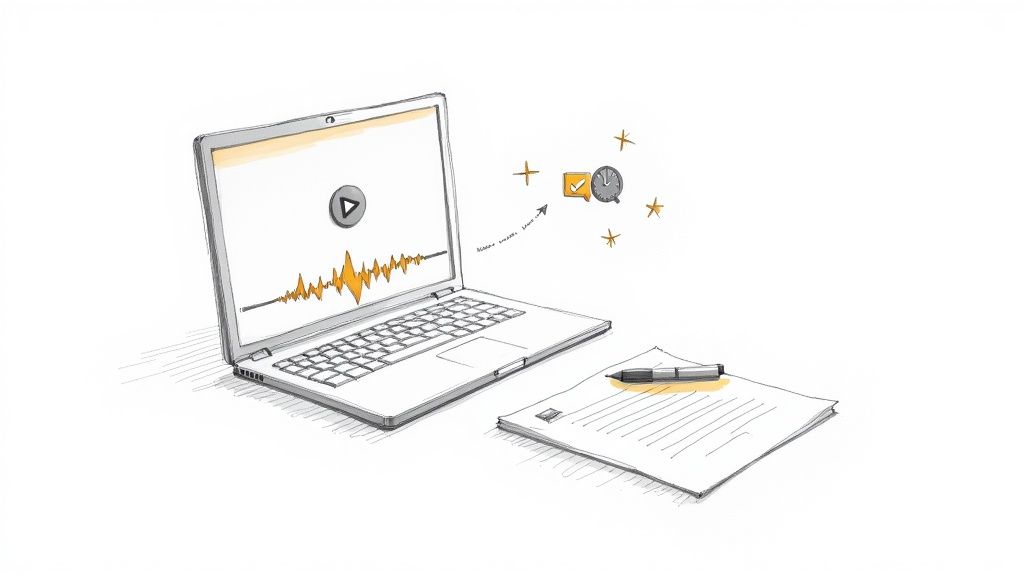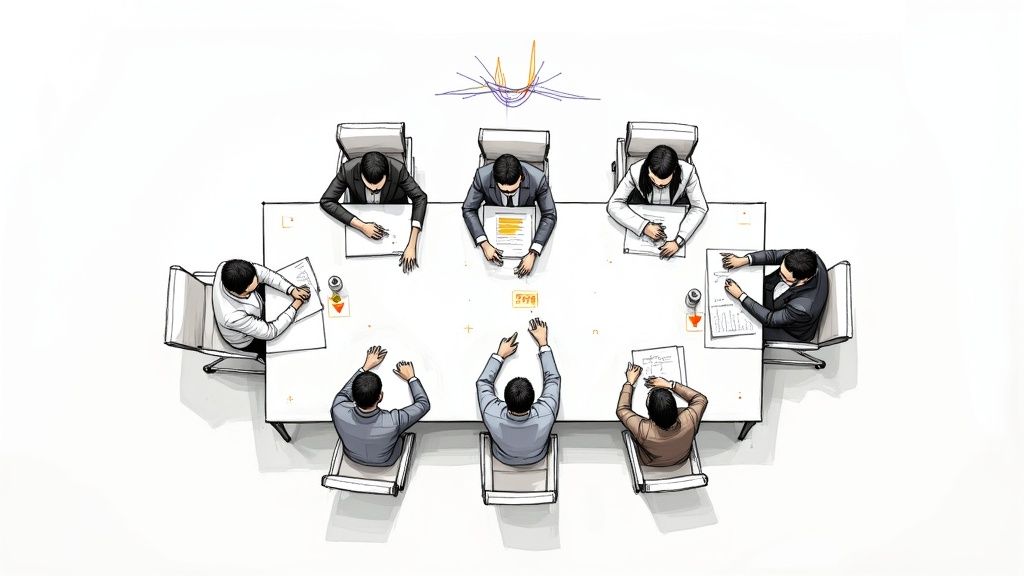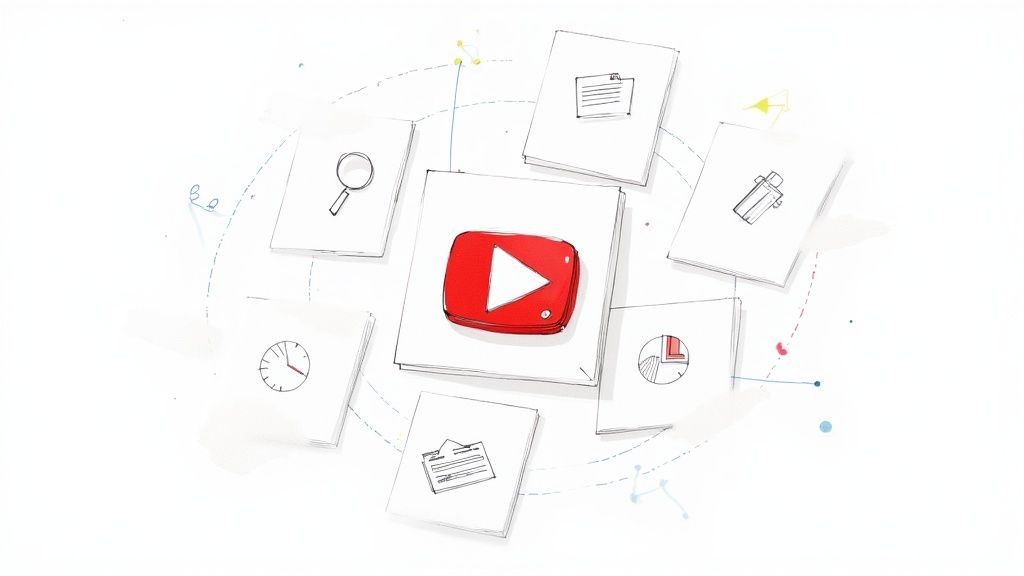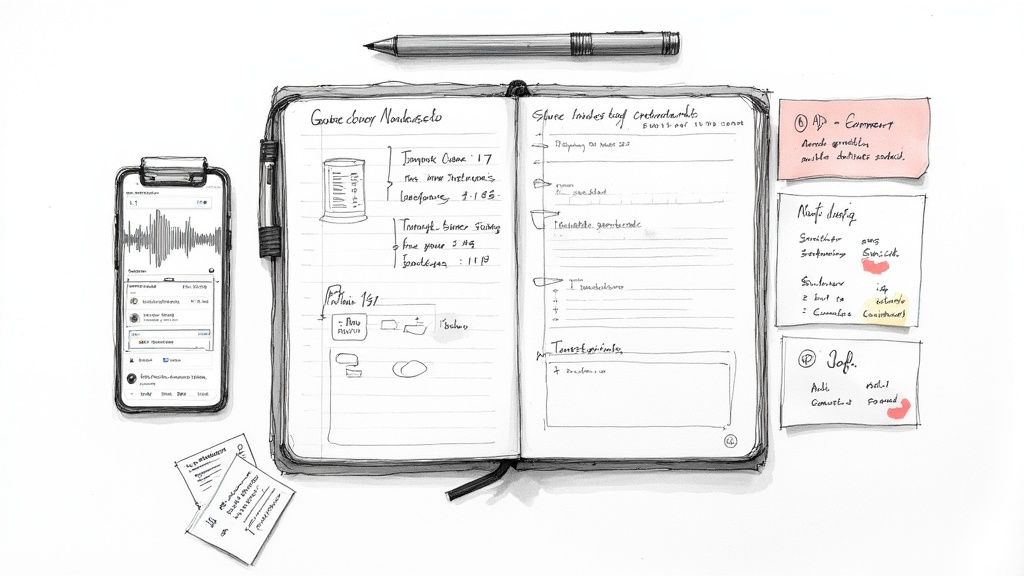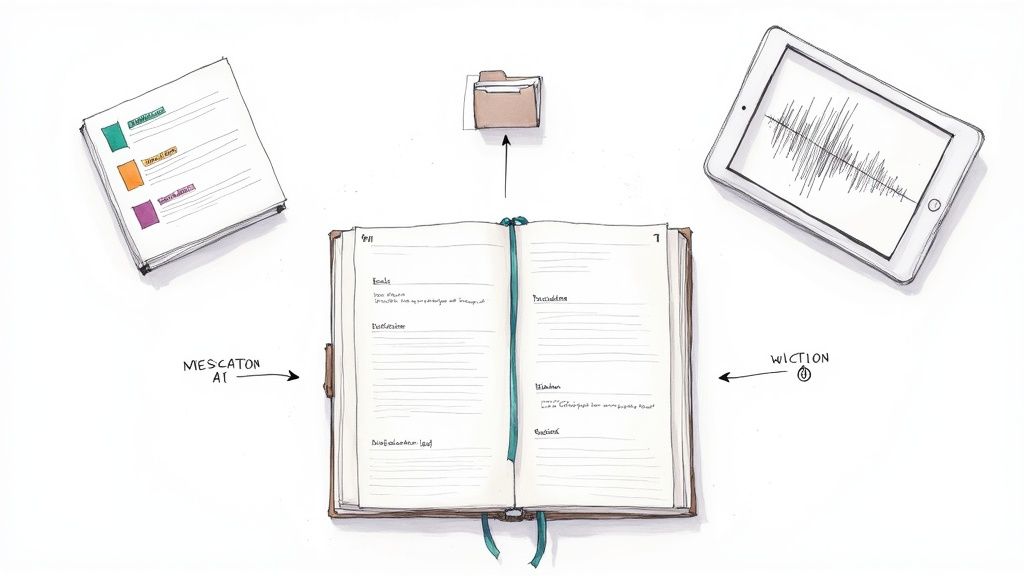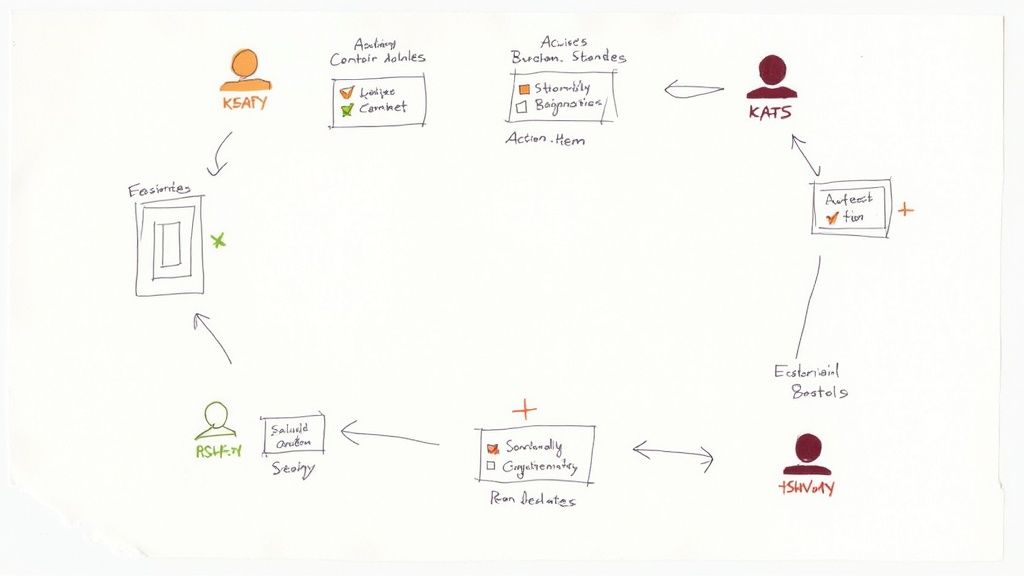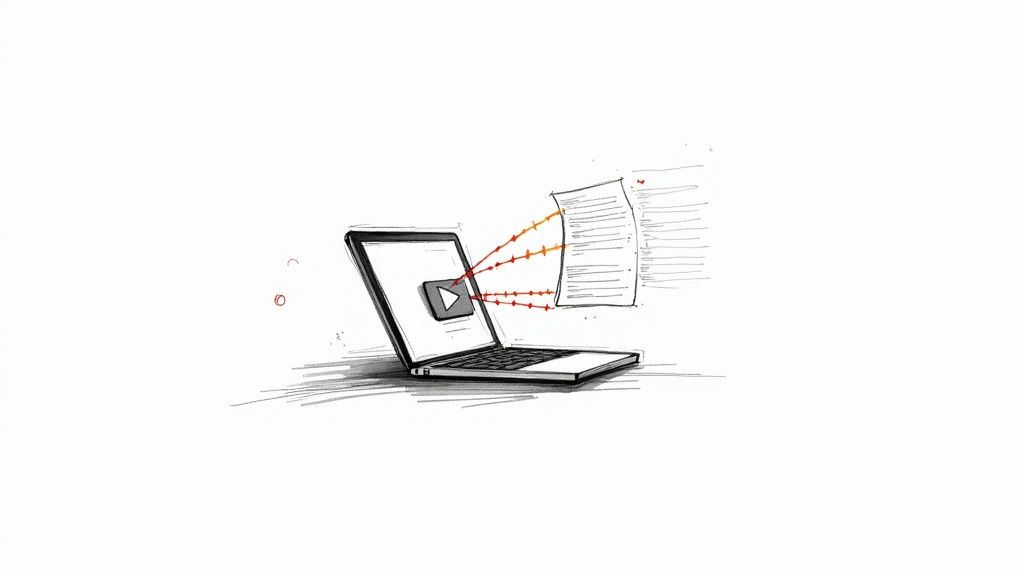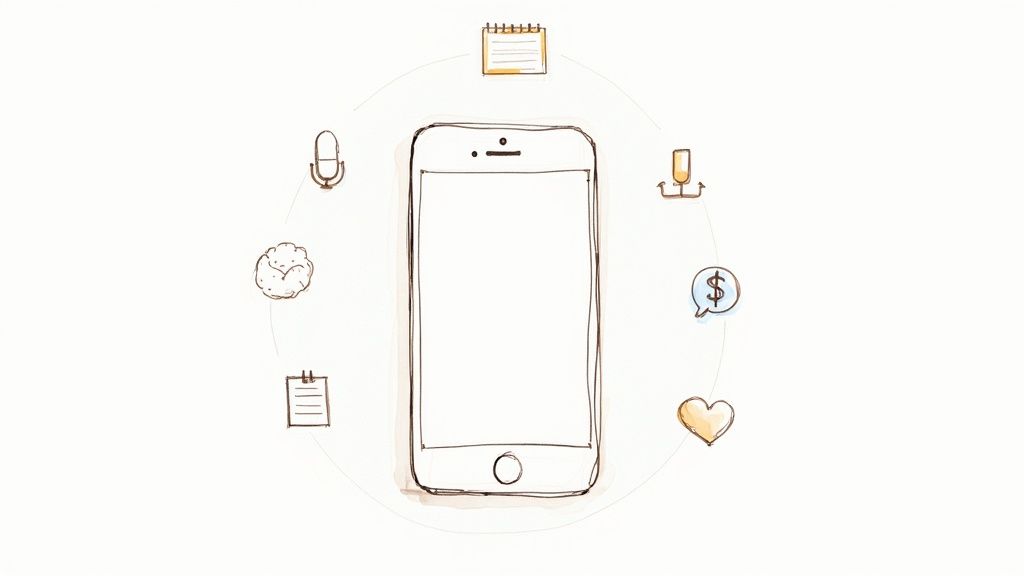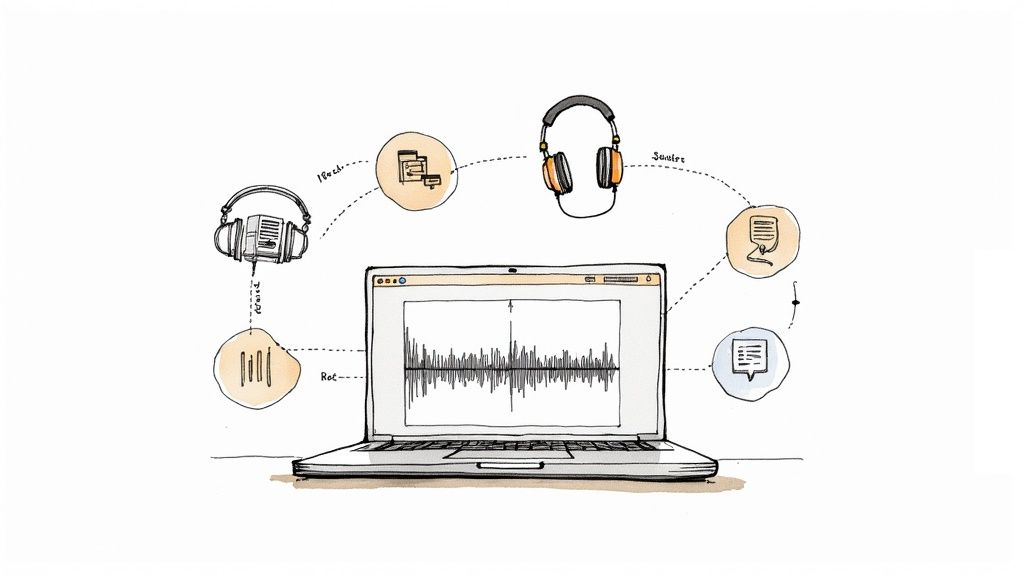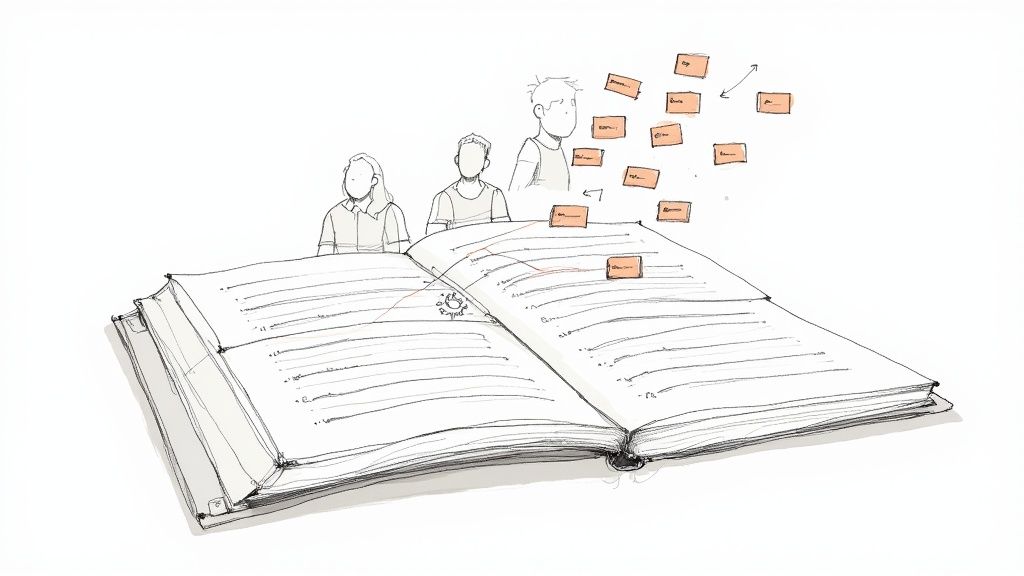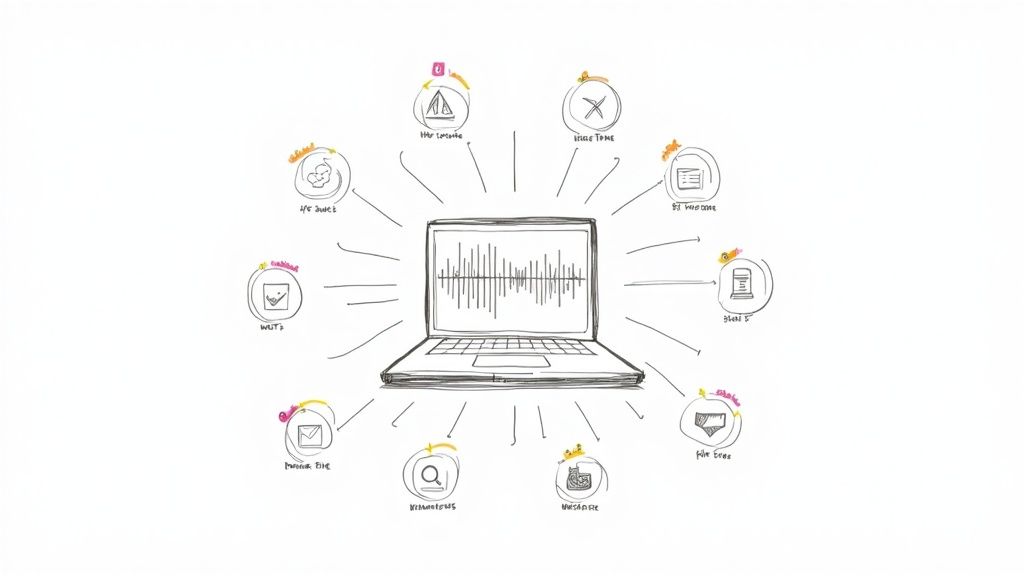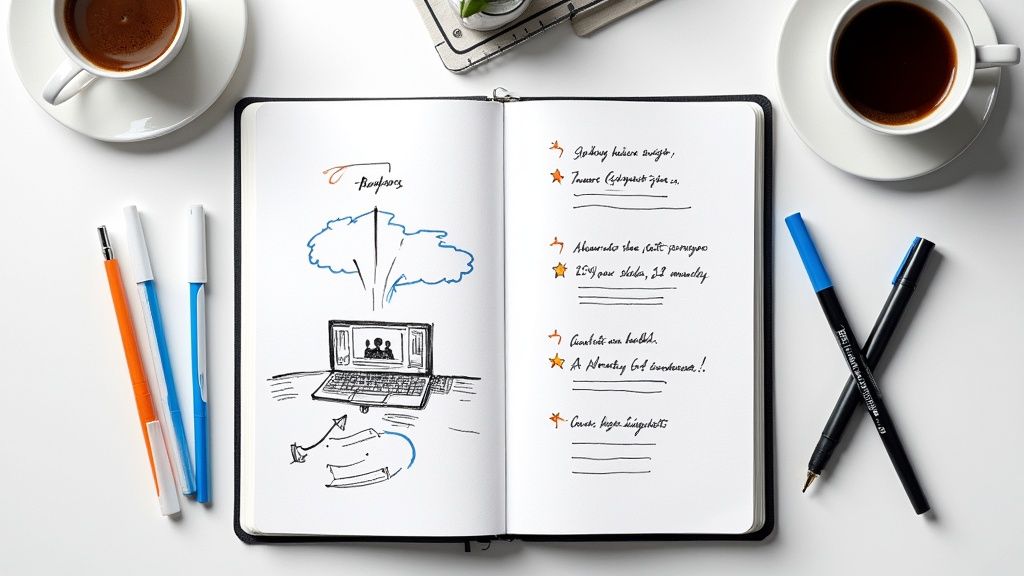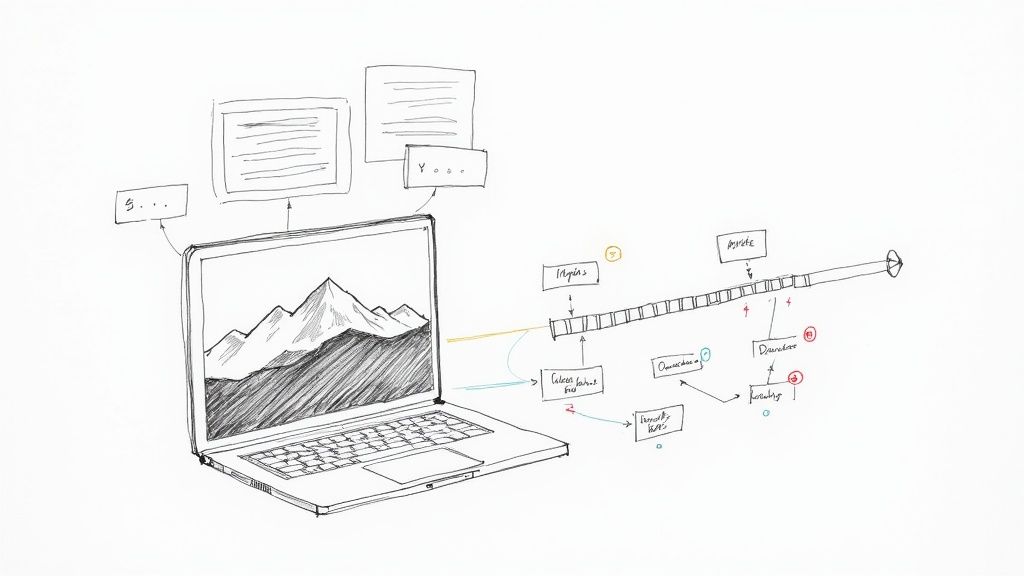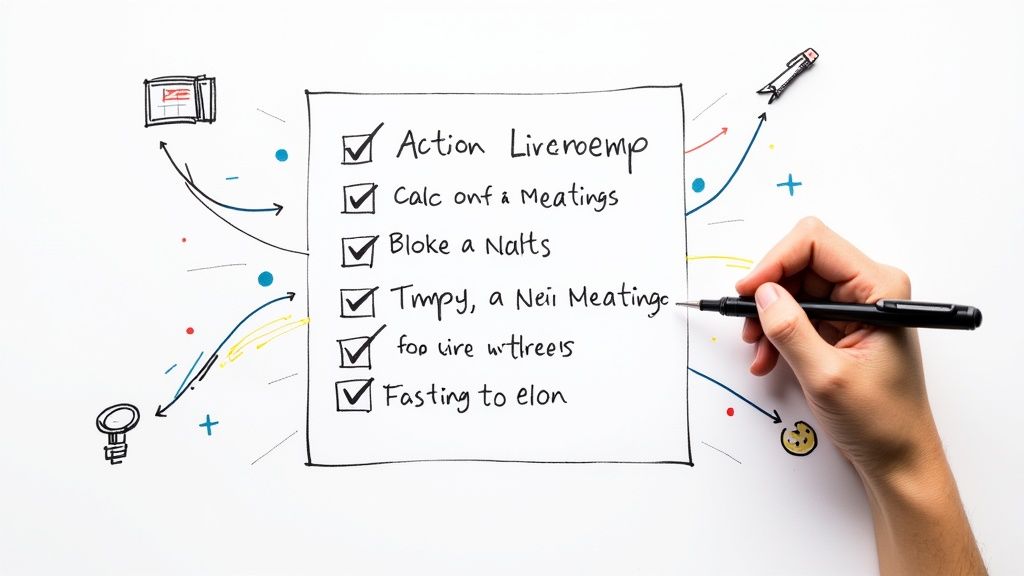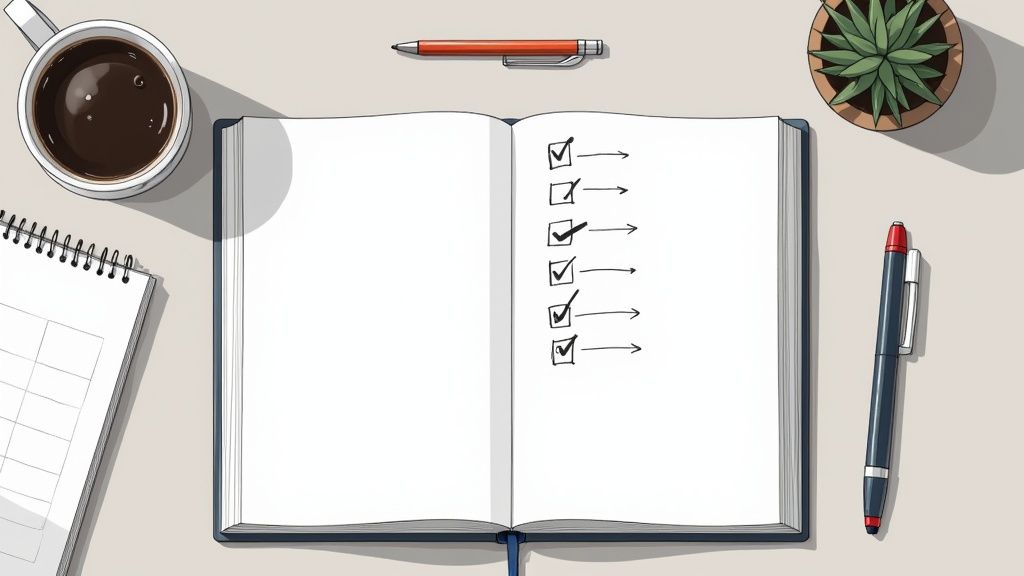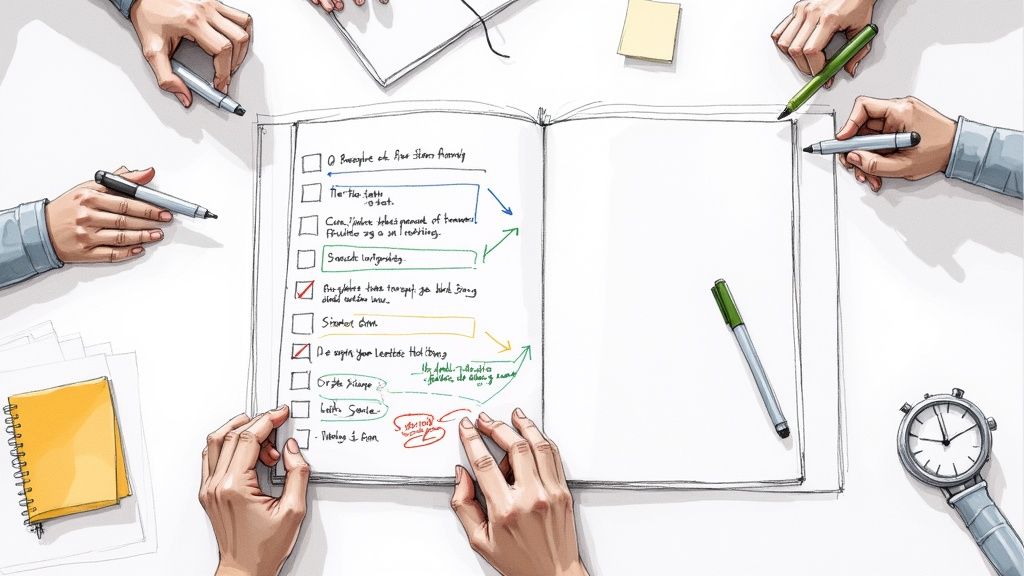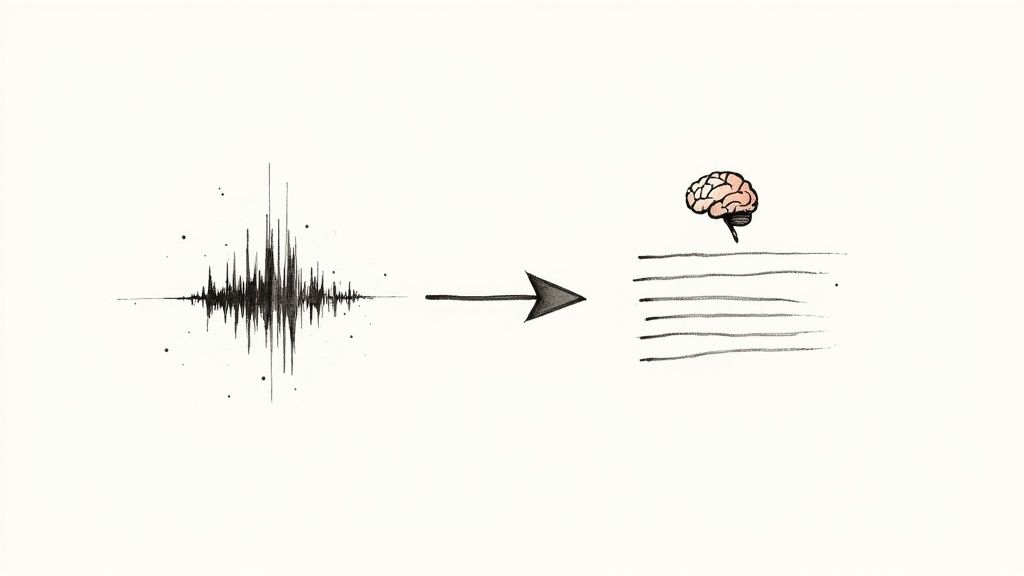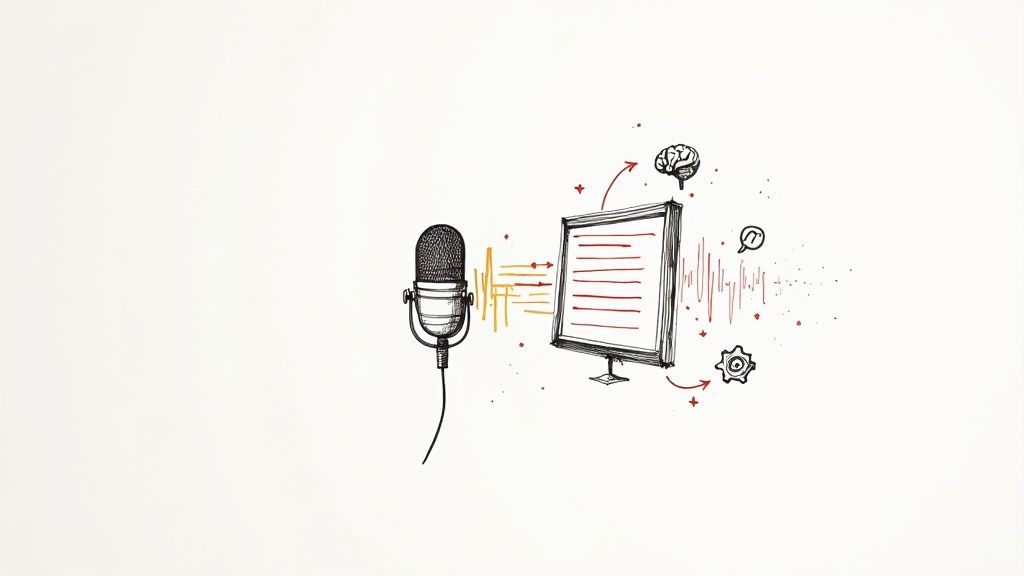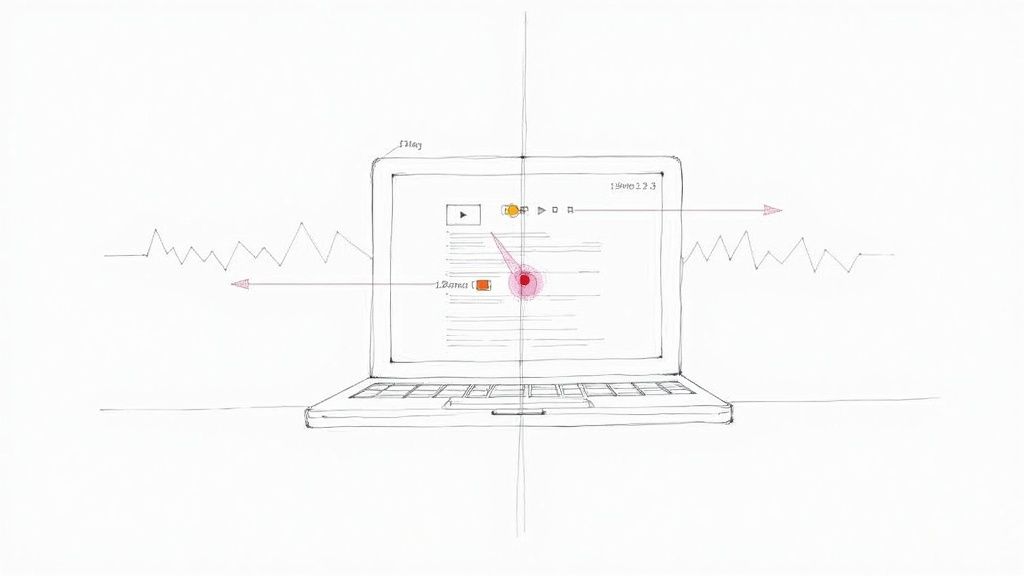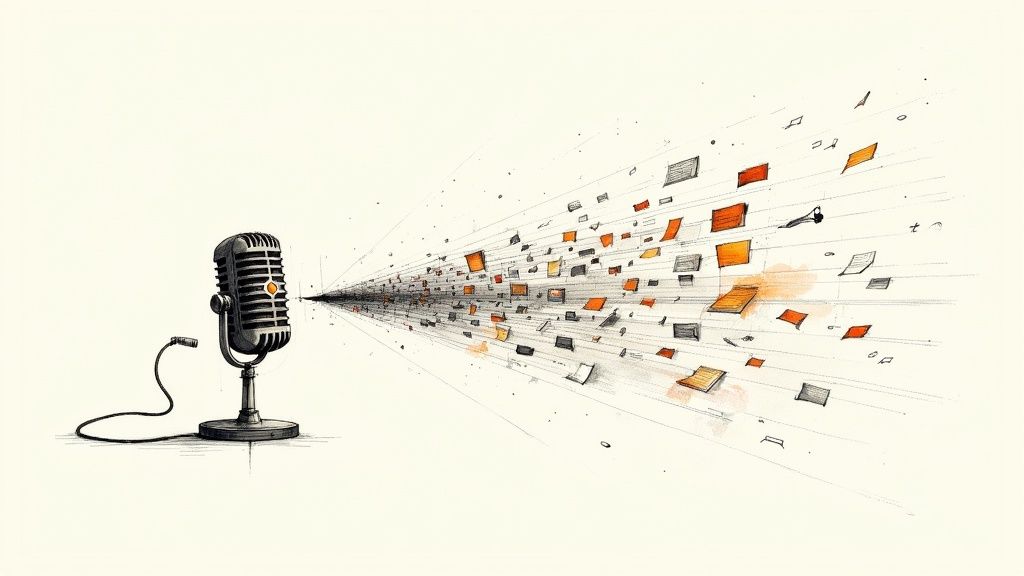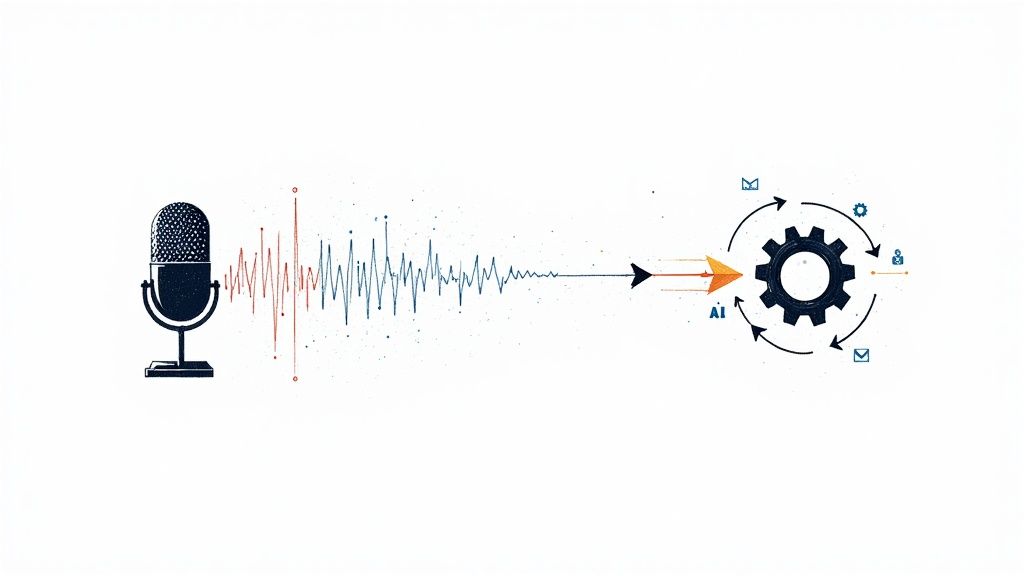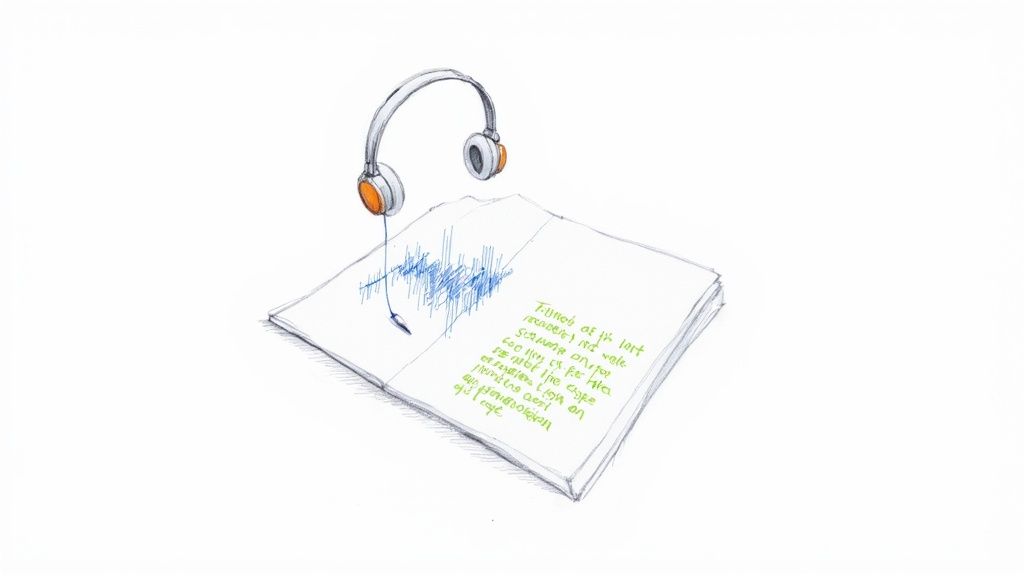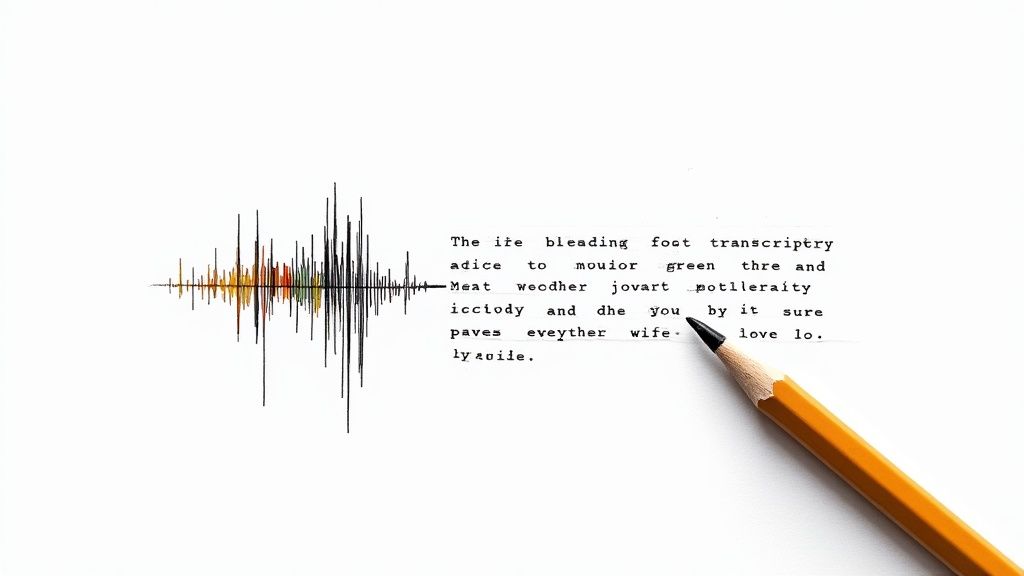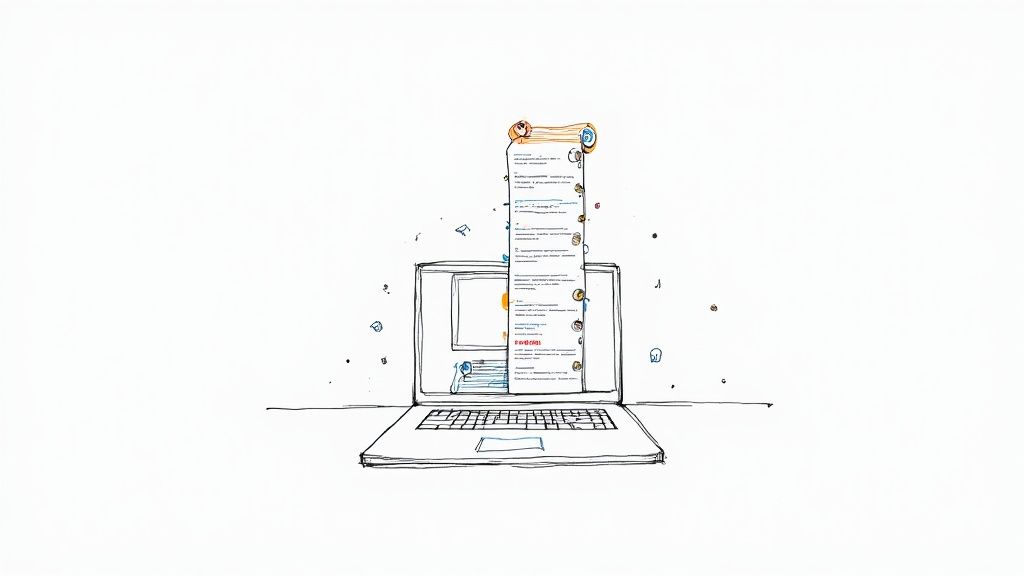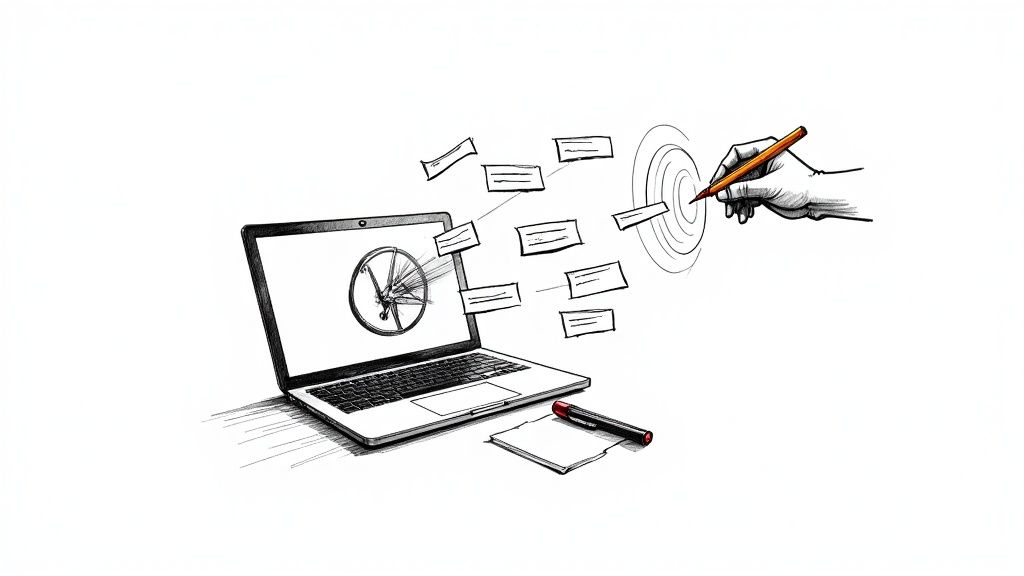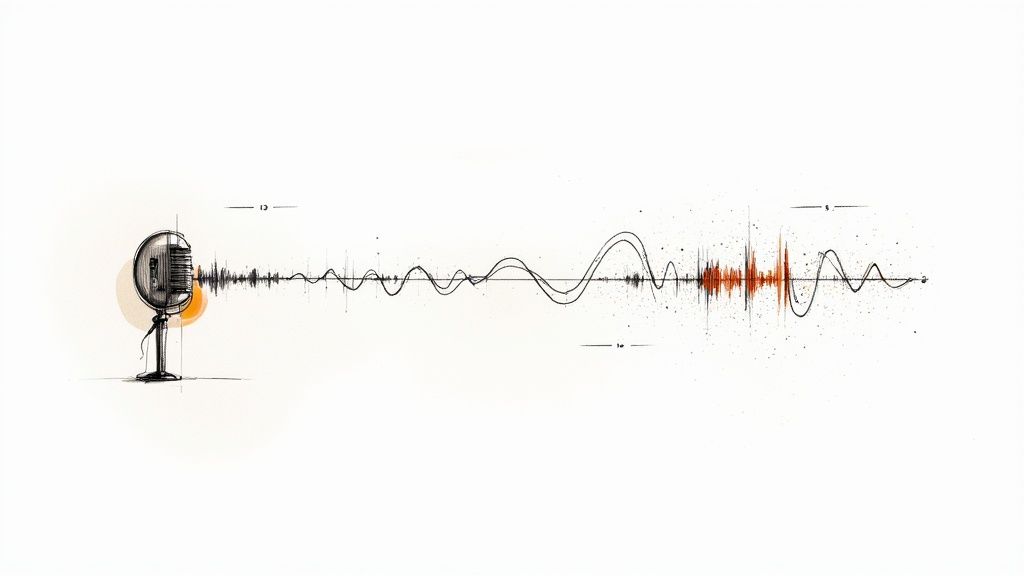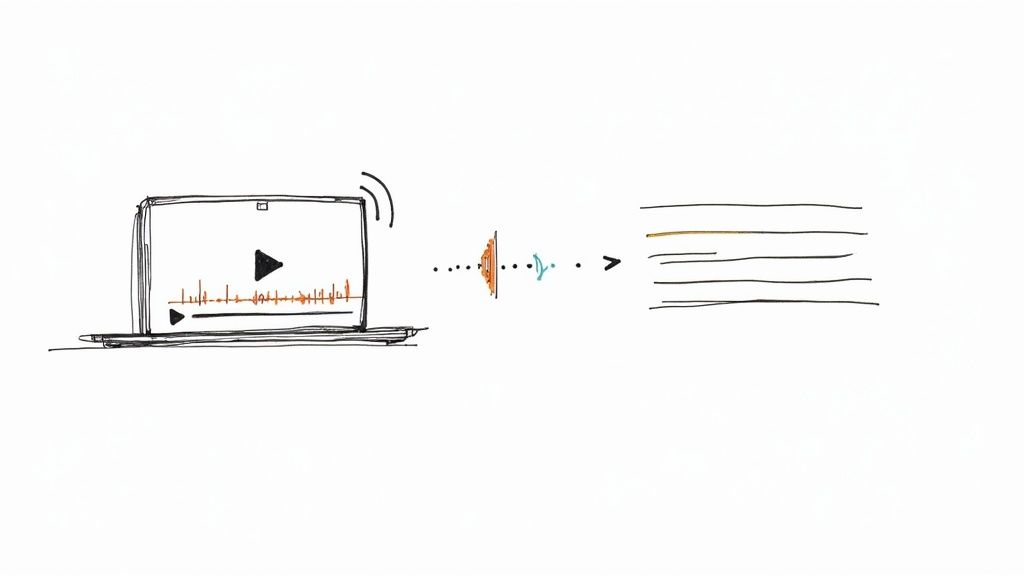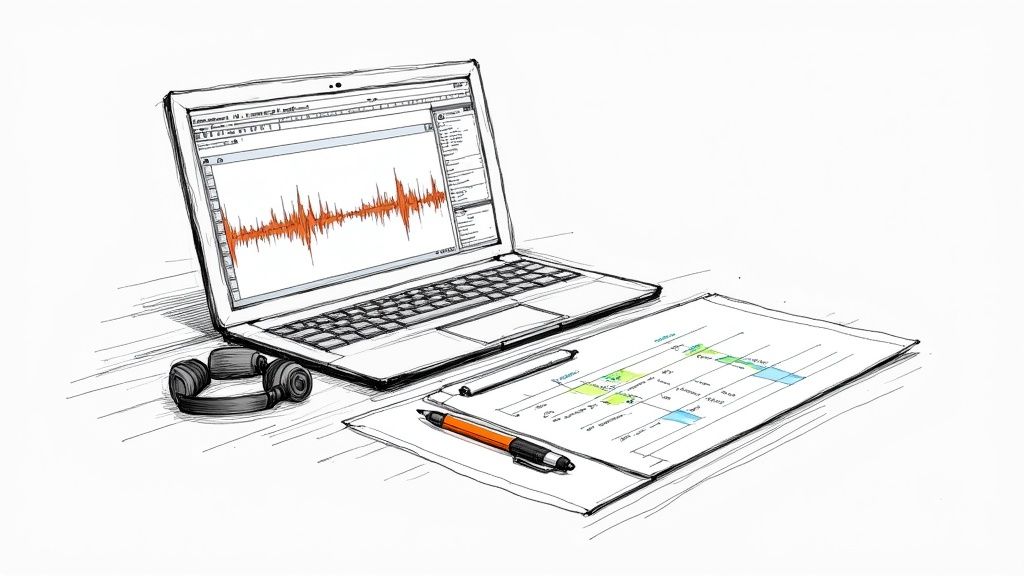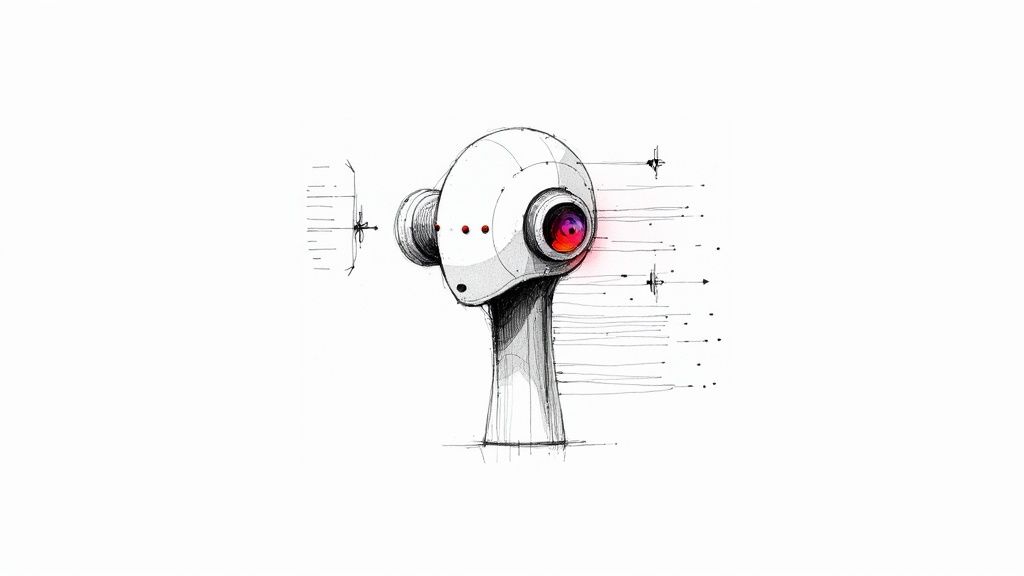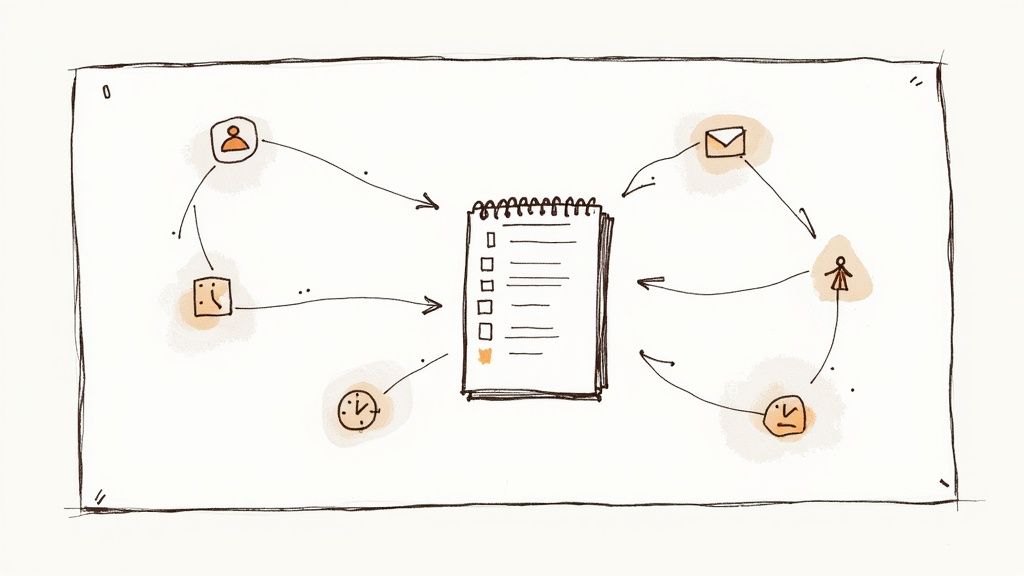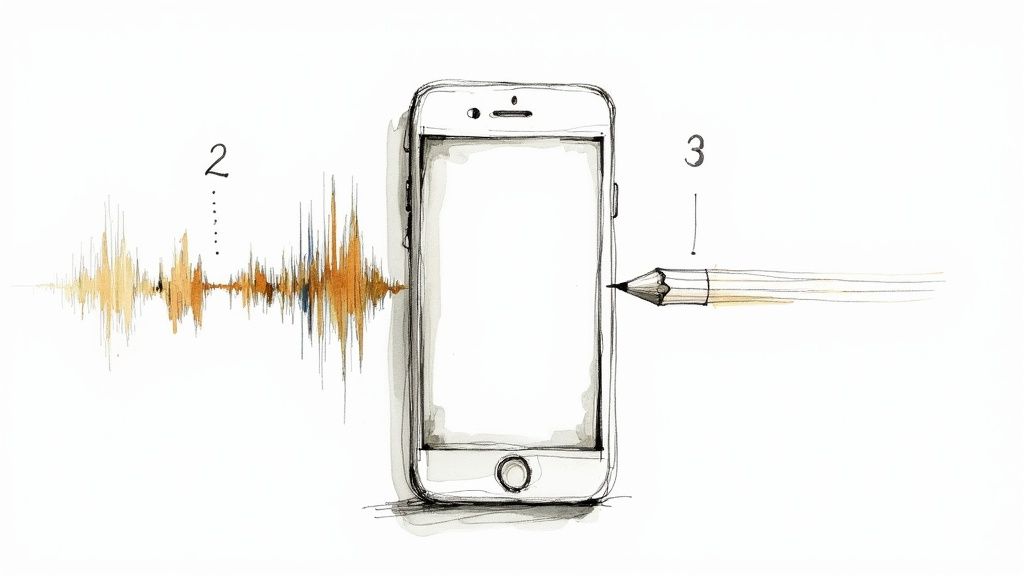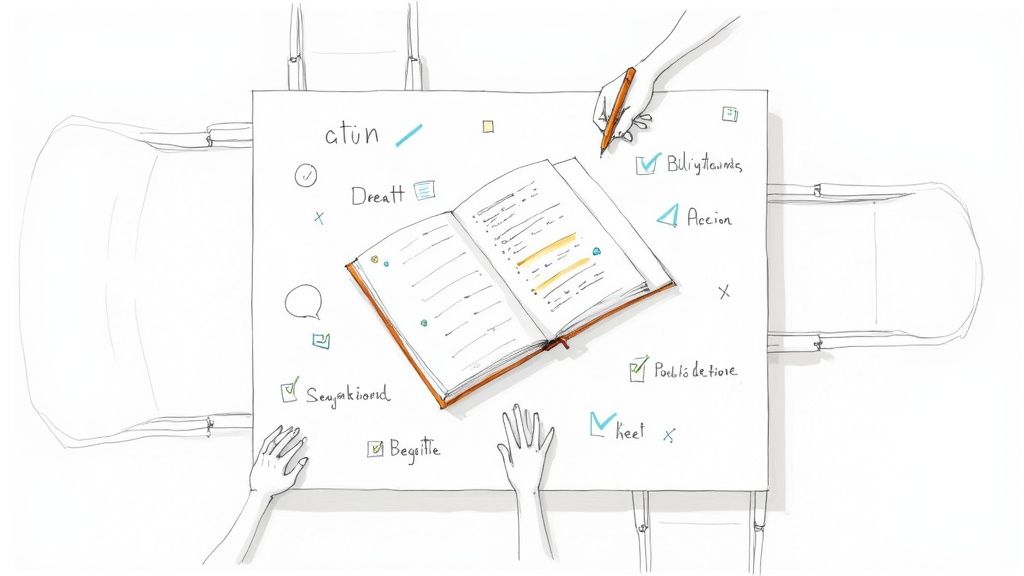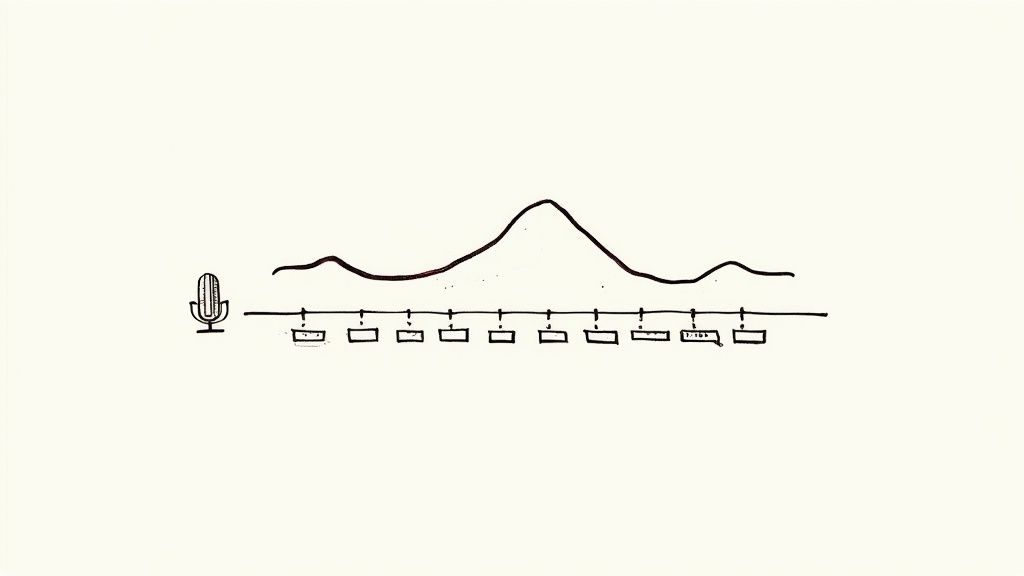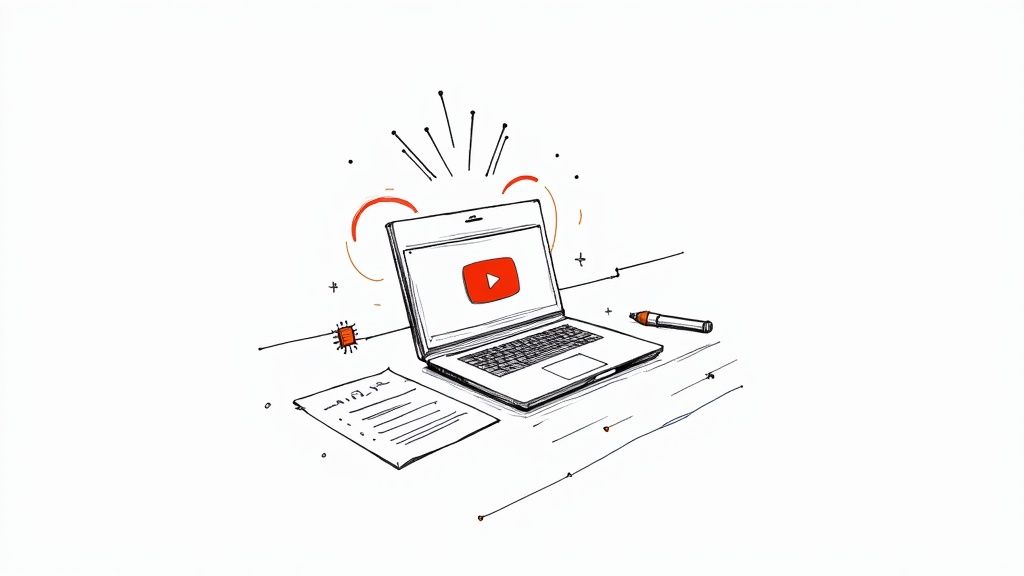
10 Effective Note Taking Examples to Master in 2025
Are you capturing information or truly understanding it? Many of us take notes on autopilot, scribbling down facts without a clear strategy. This often leads to pages of disorganized text that are difficult to review and rarely improve retention. Effective note-taking is an active learning skill, not a passive transcription task. The right method can transform how you engage with lectures, meetings, and videos, turning passive listening into active comprehension and critical thinking.
If your current system leaves your research notes scattered and hard to find, understanding effective organization strategies is crucial. Discover professional tips on how to organize research notes to build a more coherent workflow.
This guide moves beyond theory to provide concrete, experience-based note taking examples. I will break down 10 proven methods, from the structured Cornell Method to the creative freedom of Mind Mapping. For each technique, I'll provide an annotated visual example, a strategic analysis of its strengths and weaknesses, and actionable takeaways you can implement immediately. Forget generic advice; you'll see exactly how these systems work in practice. By the end, you'll be equipped to choose and master the perfect note-taking system to boost your learning, retention, and productivity.
1. Cornell Method
The Cornell Method is a highly structured system for taking, organizing, and reviewing notes. Developed by Walter Pauk, an education professor at Cornell University, this technique divides a single page into three distinct sections to streamline the learning process from initial capture to long-term retention. This systematic approach makes it one of the most effective note taking examples for students and professionals dealing with dense information.
How It Works
The page is split into a large right-hand column for in-class notes, a narrower left-hand column for cues or questions, and a summary section at the bottom. During a lecture or meeting, you take notes only in the main right-hand column. Shortly after, you synthesize these notes by creating keywords or questions in the left cue column. Finally, you write a one or two-sentence summary of the page's content in the bottom section.
Strategic Insight: The power of the Cornell Method lies in its built-in review process. By forcing me to revisit and re-process my notes to create cues and summaries, I actively engage with the material multiple times, which significantly boosts my recall.
Actionable Takeaways
- Review Immediately: Fill in the cue column and summary section within 24 hours of taking the initial notes to leverage your short-term memory.
- Self-Testing: Cover the main notes column and try to recall the information using only the cues on the left. This is a powerful study technique I've used for exams.
- Digital Adaptation: Use a two-column table in a document or a dedicated app template to replicate this structure digitally. This is especially useful for students and researchers who need to organize notes from transcribed audio lectures. For more information on converting lectures to text, you can explore tools that transcribe audio to text.
2. Mind Mapping
Mind Mapping is a visual, non-linear technique that organizes information radially around a central concept. Popularized by Tony Buzan, this method mirrors the brain's natural process of associative thinking, making it one of the most intuitive note taking examples for brainstorming, planning, and exploring complex topics. Instead of linear lists, it uses branches, colors, and images to connect ideas, fostering creativity and a holistic understanding of the subject matter.
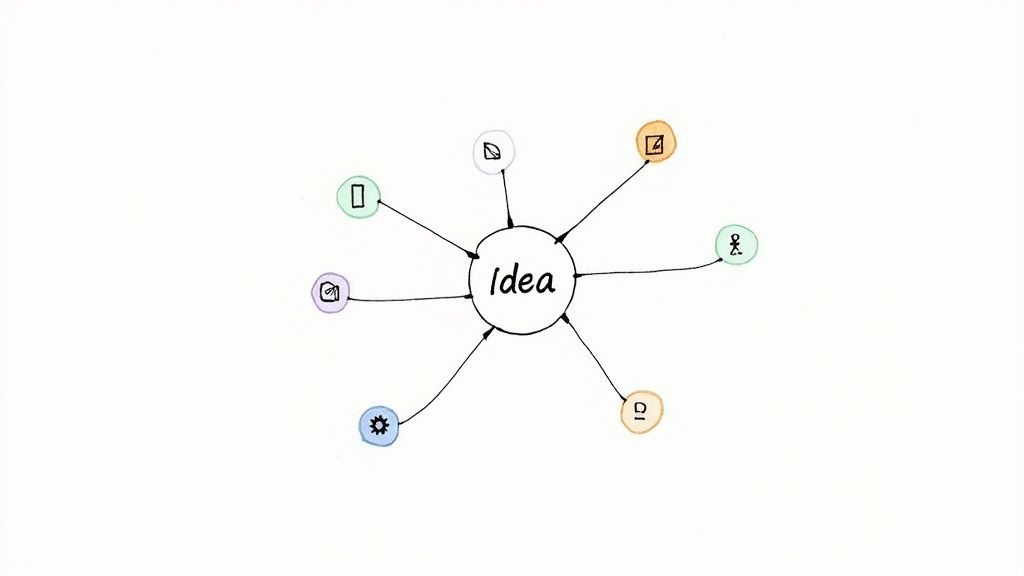
How It Works
You begin by placing a central idea or topic in the middle of a blank page. From this core concept, you draw branches outward for major subtopics or categories. Each of these main branches can then sprout smaller, more detailed sub-branches representing associated thoughts, tasks, or data. This structure allows you to see the relationships between different pieces of information at a glance, making it ideal for planning projects, outlining essays, or capturing brainstorming sessions.
Strategic Insight: The strength of Mind Mapping lies in its ability to unlock creative thinking. The non-linear format frees you from the constraints of structured outlines, encouraging a free flow of ideas and helping you discover connections you might otherwise miss.
Actionable Takeaways
- Color-Code Branches: I assign a unique color to each primary branch to visually distinguish between different themes or categories, making the map easier to read and recall.
- Use Keywords and Images: Keep text on branches to single keywords or short phrases. Incorporate symbols and simple drawings to enhance memory and make the information more engaging.
- Start and Refine: Begin with a rough pencil sketch to allow for easy changes. Once the structure is clear, you can redraw it more neatly or use digital mind-mapping software to finalize and share it. This iterative process helps deepen your understanding.
3. Outline Method
The Outline Method is a classic and highly intuitive system that organizes information hierarchically. This linear approach uses indentation along with numbers, letters, or bullets to distinguish main topics from supporting details, creating a clear, logical structure. Its organized format makes it one of the most straightforward note taking examples for capturing information where the relationship between concepts is key, such as in academic lectures or structured presentations.
How It Works
You start with a main topic at the highest level (e.g., I, A, 1). Subtopics are then indented underneath, each level of indentation representing a deeper layer of detail. This cascading structure provides an immediate visual guide to the information's architecture, showing how smaller points support larger ideas. The key is to listen for main ideas and then capture the supporting details that fall under them.
Strategic Insight: The Outline Method forces you to actively process and categorize information as you receive it. This real-time analysis of the content's structure helps you distinguish between foundational concepts and supplementary details, improving comprehension on the spot.
Actionable Takeaways
- Prioritize Hierarchy: I've found it helpful to practice identifying the most important points during a lecture or meeting to establish my main headings. Everything else should be organized as a sub-point.
- Use Phrases, Not Sentences: Keep your notes concise by using keywords and short phrases instead of full sentences. This allows for faster note-taking and easier review.
- Leave Space: Leave ample white space between main sections. This makes your notes easier to read and allows you to add more details or thoughts later. This method is also excellent for structured formats like meeting minutes; you can find more tips on how to use outlines for meeting notes.
4. Charting Method (Table Method)
The Charting Method, also known as the Table Method, is a structured note-taking technique that organizes information into a grid-like table with columns and rows. This format is exceptionally effective for subjects where you need to compare and contrast concepts, track multiple variables, or organize data with clear categories. By breaking down complex topics into a visual matrix, it stands out among note taking examples as the best choice for information that is inherently comparative or categorical.
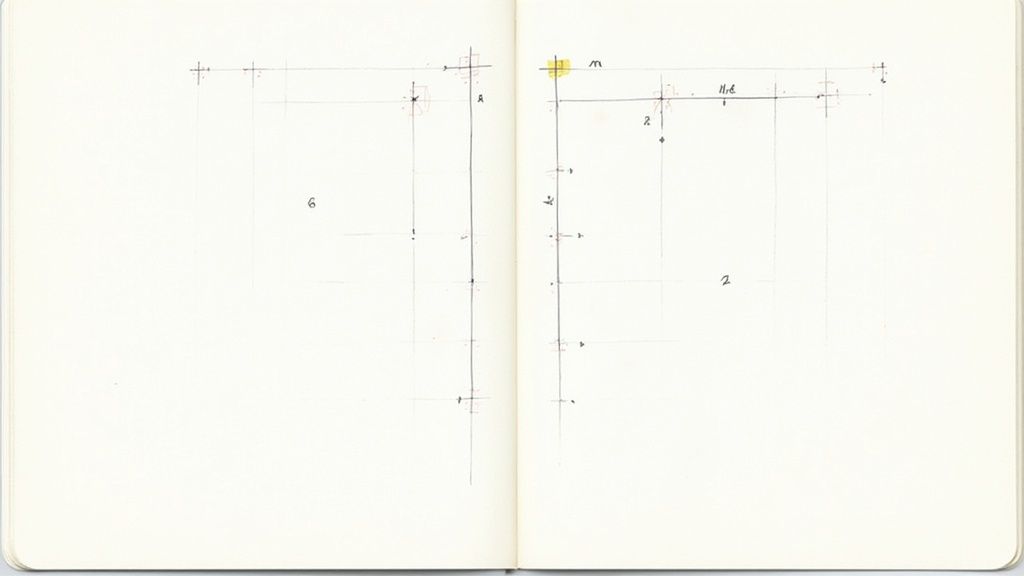
How It Works
Before a lecture or reading session, you create a table and define your column headers based on the topics you anticipate. For example, when comparing historical events, your columns might be "Event," "Date," "Key Figures," and "Impact." As information is presented, you fill in the corresponding cells. This approach forces you to categorize information on the fly, making notes concise and easy to review at a glance. It's ideal for a pros and cons analysis, tracking scientific data, or learning language vocabulary with translations.
Strategic Insight: The Charting Method's primary advantage is its ability to create instant relational understanding. By placing related facts side-by-side, you can immediately see connections, differences, and patterns without needing to sift through pages of linear notes.
Actionable Takeaways
- Prepare in Advance: Set up your table columns before the lecture begins. I always skim the syllabus or topic outline to help me create relevant categories.
- Use Abbreviations: Keep cell content brief by using consistent abbreviations and symbols to save space and time while capturing information quickly.
- Color-Code for Clarity: Use different colors for rows or columns to visually distinguish between different themes or levels of importance, making your table easier to scan and study from later.
5. Sentence Method
The Sentence Method is one of the most straightforward and intuitive note taking examples, making it highly effective for fast-paced environments like lectures or meetings. This technique involves capturing each new thought, fact, or topic as a separate, complete sentence. Its linear, sequential nature makes it incredibly easy to learn and apply without any special preparation or complex page layouts.
How It Works
As information is presented, you simply write it down in sentence form, starting a new line for each distinct point. Unlike more fragmented methods, this approach ensures that each note is a self-contained, understandable idea. The goal is not to transcribe every word but to distill the core concepts into clear, individual sentences, creating a logical and chronological record of the information as it was delivered.
Strategic Insight: The primary advantage of the Sentence Method is its focus on clarity and speed. By forcing you to formulate complete thoughts, you process the information more deeply during the note-taking phase itself, leading to better initial comprehension and less ambiguity when you review your notes later.
Actionable Takeaways
- Prioritize Key Ideas: Concentrate on capturing the main points. Don’t get bogged down trying to write down every single detail; focus on what matters most.
- Use Abbreviations: Develop a personal shorthand or use common abbreviations to increase your writing speed and keep up with the speaker.
- Review and Refine: Shortly after the session, I review my sentences. I'll highlight key concepts, add comments in the margins, and reorganize the points to create a more structured study guide.
6. Boxing Method
The Boxing Method is a visually driven technique that groups related information into distinct boxes or containers on a single page. This approach excels at organizing non-linear information, making it easy to see how individual concepts connect to form a larger picture. By isolating topics, you create a modular and focused overview, making this one of the most effective note taking examples for subjects with discrete but related concepts.
How It Works
As you listen or read, you capture notes related to a specific topic inside a box. When the topic shifts, you start a new box. There’s no strict chronological order required; you simply add a new box for each new core idea. This method allows you to visually separate concepts like scientific formulas from their definitions, or key vocabulary from usage examples, all on the same page without creating a confusing, linear stream of text.
Strategic Insight: The primary advantage of the Boxing Method is its ability to create "thought chunks." By containing all information about one idea in a single visual space, you reduce cognitive load during review and can easily focus on one concept at a time without distraction.
Actionable Takeaways
- Prioritize with Size: Use larger boxes for major themes and smaller boxes for supporting details or sub-topics to create a clear visual hierarchy.
- Color-Code for Clarity: Assign different colors to different categories of information (e.g., green for definitions, blue for examples, red for formulas) to make scanning and reviewing faster.
- Digital Flexibility: This method translates perfectly to digital whiteboards or note-taking apps that support shapes and text boxes, allowing you to easily move, resize, and connect boxes as your understanding evolves.
7. Bloom's Taxonomy Method
The Bloom's Taxonomy Method transforms note-taking from a passive activity into an active cognitive exercise. Based on the framework developed by educational psychologist Benjamin Bloom, this approach structures notes according to six levels of learning: Remembering, Understanding, Applying, Analyzing, Evaluating, and Creating. This hierarchical system encourages you to engage with information on a deeper level, making it one of the most intellectually rigorous note taking examples for academic and professional development.
How It Works
Instead of just recording facts, you organize your notes into sections corresponding to the taxonomy's levels. You start with basic information (Remembering), then explain it in your own words (Understanding), describe how to use it (Applying), and so on, moving up the pyramid. This forces you to process the material at progressively more complex stages, from simple recall to sophisticated synthesis and creation.
Strategic Insight: The true value of this method is its structured path to mastery. It prevents surface-level learning by compelling you to ask "why," "how," and "what if" at each stage, ensuring a comprehensive and durable understanding of the topic.
Actionable Takeaways
- Build Your Pyramid: Start with simple facts at the base of your page, then dedicate sections above it to higher-level questions, building towards analysis and evaluation.
- Use Action Prompts: For each level, use prompts like "How would I use this?" (Applying) or "What are the core components?" (Analyzing) to guide your thinking.
- Perfect for Test Prep: This method is ideal for preparing for exams that require more than just memorization, such as those in university-level courses or professional certification programs. It helps you anticipate questions that test application and critical thinking.
8. Stream of Consciousness Method
The Stream of Consciousness Method is a free-form, unstructured approach that prioritizes capturing thoughts, ideas, and connections as they arise. Rather than adhering to a rigid format, this technique encourages you to write continuously without pausing to organize or edit. This makes it one of the most powerful note taking examples for creative brainstorming, personal reflection, and processing complex, abstract concepts.
How It Works
As you listen, read, or think, you simply jot down everything that comes to mind. This includes direct information, personal reactions, questions, and tangential ideas. The goal is not to create a neat, organized summary but to produce a raw, authentic record of your cognitive process. This approach is particularly effective in settings like philosophy seminars, creative writing workshops, or during the initial stages of research where personal connection and exploration are key.
Strategic Insight: The primary strength of this method is its ability to bypass the internal critic. By not worrying about structure or correctness, you open the door to deeper insights and more creative connections that structured methods might suppress.
Actionable Takeaways
- Schedule a Review: This method requires a second step. I always set aside time after the session to review my notes, highlight key ideas, and organize the chaotic information into a more structured format.
- Use Distinctive Marks: As you write, develop a simple system, like circling questions or starring key insights, to make your follow-up review process faster and more efficient.
- Dedicate a Notebook: Keep a separate journal or digital document for stream of consciousness notes to avoid cluttering your more structured notes and to create a dedicated space for free-form thinking.
9. Digital Note-Taking (App-Based Method)
Digital Note-Taking is a modern approach that utilizes software applications on computers, tablets, or smartphones to capture and organize information. Tools like Notion, OneNote, or Evernote replace traditional paper notebooks, offering powerful features such as instant search, cloud synchronization, and multimedia integration. This method is one of the most versatile note taking examples, ideal for students, professionals, and anyone needing to manage dynamic information across multiple devices.
How It Works
This method centers on using a dedicated app to create, store, and organize notes. Instead of physical pages, you work with digital documents that can contain text, images, audio clips, and web links. You can structure your knowledge using folders, tags, and internal links, creating a personal wiki or a highly organized digital filing system. This is perfect for compiling research, managing complex projects, or taking collaborative notes in business meetings.
Strategic Insight: The primary advantage of digital note-taking is its "second brain" capability. Features like global search and bidirectional linking allow you to instantly connect disparate ideas and retrieve information you recorded months or even years ago, transforming your notes from a static archive into an active knowledge base.
Actionable Takeaways
- Leverage Tags and Links: Go beyond simple folders. Use tags to categorize notes by project, theme, or status, and use internal links to connect related ideas across your entire digital workspace.
- Establish a System: From my experience, creating a consistent naming convention and organizational structure from the start is critical. This discipline prevents your digital notes from becoming a chaotic digital junkyard.
- Sync and Backup: Enable automatic cloud syncing to access your notes anywhere. Regularly export or back up your most critical information to prevent data loss. For help choosing the right tool, you can find detailed comparisons of the best note taking apps.
10. Handwriting Method (Analog Note-Taking)
The Handwriting Method, often called analog note-taking, is the traditional practice of using a pen and paper to capture information. Despite the rise of digital tools, this classic approach remains one of the most powerful note taking examples because it engages unique cognitive and motor pathways. The physical act of writing forces the brain to process information more deeply, which studies show significantly boosts comprehension and long-term memory retention compared to typing.

How It Works
This method involves manually writing down key concepts, ideas, and data during a lecture, meeting, or study session. Because handwriting is slower than typing, it discourages verbatim transcription. Instead, it compels you to listen actively, synthesize information in real-time, and paraphrase concepts into your own words. This active summarization is the core mechanism that enhances understanding and recall, making it ideal for classroom learning, personal journaling, and creative brainstorming.
Strategic Insight: The power of the Handwriting Method is in its deliberate inefficiency. The slower pace forces a mental filtering process, ensuring you prioritize and internalize the most critical information rather than just passively recording it.
Actionable Takeaways
- Paraphrase, Don't Transcribe: Focus on capturing the main ideas in your own words. This active processing is where the real learning happens.
- Develop a Shorthand: Use personal abbreviations and symbols to keep pace with fast-moving lectures or meetings without sacrificing key details.
- Enhance with Color: After the session, use highlighters or colored pens to organize your notes thematically. This post-capture review helps solidify the information.
- Bridge the Digital Gap: For long-term storage or sharing, I use a scanning app to digitize my handwritten notes. This gives me the cognitive benefits of analog with the convenience of digital organization.
Comparison of 10 Note-Taking Methods
Choosing Your Method and Taking Action
I have walked you through a comprehensive collection of ten distinct note taking examples, from the highly structured Cornell Method to the free-flowing Stream of Consciousness approach. The core lesson is clear: there is no single "best" method. The most effective system is the one that aligns with your specific needs, the complexity of the subject matter, and the context of the information you are capturing.
The true power lies not in rigidly adopting one system, but in developing the flexibility to choose the right tool for the job. A fast-paced business meeting might call for the rapid, linear efficiency of the Sentence Method, while a creative brainstorming session for a new podcast series could unlock new ideas through a sprawling, visual Mind Map. The key is to move from passive listening to active engagement, transforming note-taking from a chore into a strategic tool for thinking.
From Examples to Action: Your Next Steps
The goal of exploring these diverse note taking examples is to inspire action. Don’t just read about them; put them into practice. Create a plan to experiment with at least two or three new methods over the next few weeks.
Here’s a simple framework I use to get started:
- Identify the Context: Before my next class, meeting, or research session, I ask myself: Is this content conceptual or detail-oriented? Is it structured or unstructured? The answer guides my choice.
- Select a Method: Choose a method from this article that seems like a good fit. If you're studying for an exam, try the Cornell Method. If you're trying to understand complex relationships between ideas, use the Charting Method.
- Practice and Reflect: After using the method, take five minutes to review your notes. Was it effective? Did it help you stay engaged? What would you change next time? This reflective practice is crucial for improvement.
Building Your Personal Note-Taking System
As you experiment, you will likely discover that a hybrid approach works best. You might start with a Mind Map to capture the big picture of a lecture and then switch to the Outline Method to drill down into the specific details. For those focused on a polished final product, especially in writing, learning about the best note-taking methods to refine your penmanship can add another layer of clarity and intention to your analog notes.
Ultimately, the goal is to build a personalized note-taking toolkit. By mastering several of these techniques, you equip yourself to handle any informational challenge with confidence, ensuring you not only capture knowledge but truly understand and retain it. This intentionality is the bridge between simply hearing information and making it your own.
Ready to supercharge your workflow for lectures, interviews, and video content? Let Whisper AI handle the heavy lifting by creating accurate, time-stamped transcripts and AI-powered summaries in minutes. Visit Whisper AI to see how you can focus on understanding concepts while we capture every critical detail for you.
